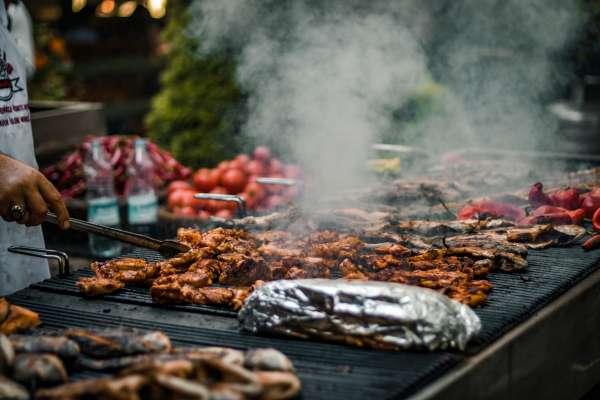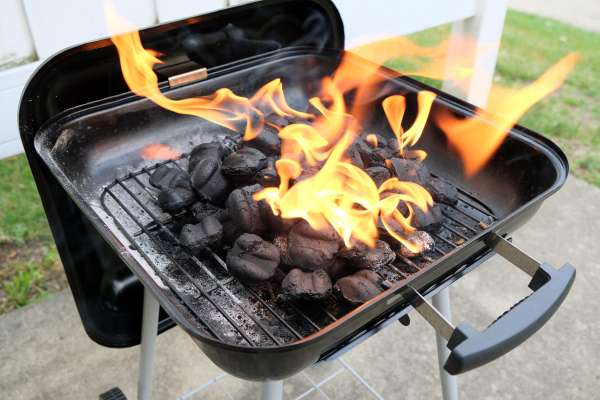Delving into the world of outdoor barbecues, the question of how hot do charcoal grills get is crucial for enthusiasts aiming to perfect their grilling techniques. Charcoal grills are celebrated for their ability to achieve high temperatures, which is vital for searing meats to perfection and unlocking a smoky flavor that is hard to replicate with other types of grills. The benefits of understanding the temperature capabilities of charcoal grills extend beyond just flavor enhancement; it’s important for ensuring food safety, optimizing cooking times, and broadening your grilling menu. This knowledge empowers grillers to make informed decisions about heat management, allowing for a versatile and satisfying cooking experience.
How Hot Can A Charcoal Grill Get?
A charcoal grill can reach temperatures up to 700-800 degrees Fahrenheit, depending on the type of coal used and the airflow control. The high heat generated by a coal grill is ideal for searing meats and achieving that desirable caramelization on the surface. However, it is important to monitor and regulate the temperature carefully to prevent burning or overcooking the food.
Is It Safe To Cook On A Charcoal Grill At Such High Temperatures?
Cooking on a charcoal grill at high temperatures is generally safe as long as proper precautions are taken. Charcoal grills can reach temperatures of up to 700-800 degrees Fahrenheit, which is ideal for searing meats and achieving that smoky flavor. However, it is important to maintain control over the grill and monitor the temperature closely to prevent flare-ups or burning.
Medium Heat For Versatile Cooking

Medium heat on a charcoal grill, typically ranging between 350°F to 450°F, is the sweet spot for a wide variety of grilling tasks. This temperature range is ideal for evenly cooking chicken, roasting vegetables, and grilling fish without the exterior charring too quickly. Achieving and maintaining this balanced heat allows for a versatile cooking environment. It’s essential for grillers to recognize this range as it facilitates the cooking of dishes to their full delicious potential, all while ensuring the inside is thoroughly cooked and the outside is golden and flavorful.
Managing Charcoal Distribution

The secret to controlling the temperature lies in managing charcoal distribution. For a medium heat, coals should be spread out evenly across the grill. However, creating zones of different temperatures can be advantageous. A common technique is the two-zone setup, where coals are banked to one side of the grill, creating a hotter zone for searing and a cooler zone for slower cooking. This method not only aids in preventing flare-ups but also allows for greater control over the cooking process, making it possible to move food between zones as needed to avoid over or undercooking.
Factors Influencing Temperature
1. Type Of Charcoal Used
The choice of charcoal is the first major factor affecting how hot your grills can get. Lump charcoal, made from pure hardwood, is favored for its ability to burn hot and fast, reaching temperatures upwards of 1200°F in optimal conditions. Briquettes, on the other hand, offer a more consistent burn rate and temperature, typically maxing out around 800°F to 1000°F. The difference in temperature capabilities can greatly affect cooking times and outcomes, making the choice of coal crucial depending on what you’re grilling.
2. Ventilation And Airflow
Airflow through the grill plays a pivotal role in temperature control. Oxygen feeds the flames, so adjusting the grill’s vents can either increase the heat by allowing more air in or decrease it by restricting air flow. Proper management of ventilation can create the perfect environment for anything from slow cooking to searing.
3. Grill Design And Size
The design and size of a charcoal grill also impact how hot it can get and how evenly the heat is distributed. Kettle grills, with their rounded dome design, are excellent at retaining heat, making them capable of reaching higher temperatures. Larger grills may provide more cooking surface but can struggle to reach the same peak temperatures throughout the entire grill area without the correct amount of coal and airflow.
4. External Weather Conditions
External weather conditions can influence the heat of your charcoal grill. Wind can increase airflow through the grill, pushing temperatures higher, while cold or wet weather can absorb heat, requiring more charcoal to achieve desired cooking temperatures. Understanding these external factors is crucial for outdoor cooking, ensuring that your grilling experience is successful regardless of the weather.
Low-Temperature Grilling For Slow Cooking

Low-temperature grilling, below 300°F, is perfect for slow-cooking meats to tender perfection. This gentle heat allows the inside of the meat to cook thoroughly without the outside burning. It’s the go-to method for smoking and barbecuing ribs, briskets, and pulled pork, where the goal is to break down the meat’s connective tissue slowly, rendering it deliciously tender. Mastering low-temperature grilling on a coal setup involves fewer coals, properly spaced, and occasionally replenished to maintain the desired low heat over extended periods.
Avoiding Overcooking Or Undercooking

To avoid the common pitfalls of overcooking or undercooking your food on a charcoal grill, it is crucial to understand how charcoal grills work. Charcoal grills rely on the radiant heat produced by burning coal to cook food. Properly arranging the coals and regulating their temperature is key to controlling the cooking process. Avoid flare-ups by maintaining a consistent distance between the coals and the food, preventing sudden spikes in temperature that can lead to overcooking.
Grilling Techniques For Specific Foods

Grilling techniques can vary significantly depending on the specific food being cooked. For meats like steak, it’s essential to preheat the grill to a high heat of around 450-500 degrees Fahrenheit to achieve that perfect sear on the outside while keeping the inside juicy and tender. On the other hand, delicate seafood such as shrimp or fish require a lower heat of around 350-400 degrees Fahrenheit to prevent overcooking and maintain their delicate texture.
Using Accessories Like Heat Diffusers

Accessories such as heat diffusers can significantly enhance the grilling experience on charcoal grills, which are known for their high heat capabilities. Heat diffusers distribute the grill’s heat more evenly, preventing hot spots and ensuring more consistent cooking. This is especially important for delicate foods that require a gentle heat or when cooking for extended periods. With the right accessories, grillers can fine-tune their cooking environment, making charcoal grills even more versatile and user-friendly.
Future Trends In Charcoal Grill Technology

Future trends in charcoal grill technology are set to revolutionize the way we barbecue. One key development is the integration of smart technology, such as Bluetooth connectivity, allowing users to monitor and control grill temperature remotely. Additionally, advancements in material science are leading to more durable and efficient grills that can reach higher temperatures for searing and cooking various foods. These innovations not only ensure better cooking results but also make grilling more convenient and enjoyable for users.
Mitigation Strategies For Eco-Friendly Grilling

Eco-friendly grilling is becoming increasingly important as awareness of environmental issues grows. Mitigation strategies include using sustainably sourced charcoal, employing efficient lighting techniques that reduce the amount of coal needed, and ensuring complete combustion to minimize smoke and pollutants. Additionally, incorporating reusable grilling accessories and cleaning up with eco-friendly products can further reduce the environmental impact of charcoal grilling.
Safety Considerations
1. Handling Hot Grills
Charcoal grills can reach incredibly high temperatures, often exceeding 700 degrees Fahrenheit. The extreme heat poses a significant risk if not handled properly. When dealing with hot charcoal grills, it is crucial to use appropriate tools like long-handled tongs and heat-resistant gloves to avoid burns and accidents. Additionally, maintaining a safe distance from the grill while cooking is essential to prevent injuries.
2. Preventing Flare-Ups
Flare-ups are a common occurrence with charcoal grills but knowing how to prevent and manage them is key to a safe grilling experience. These sudden bursts of flame happen when fat drips onto the coals, igniting instantly. To mitigate this risk, always trim excess fat from meats before grilling. Keep a spray bottle of water handy to douse any unexpected flames, and maintain a section of the grill coal-free as a safety zone.
To prevent flare-ups while cooking on a hot charcoal grills essential to properly manage the airflow and temperature settings. A common mistake that leads to flare-ups is dripping fat or oil hitting the hot coals, causing sudden bursts of flames. By using a drip pan or placing an aluminum foil barrier between the food and the coal, you can minimize this risk and enjoy a more controlled grilling experience.
Historical Evolution Of Charcoal Grills
The charcoal grill has a rich history, evolving from simple fire pits used by early humans to the sophisticated cooking appliances we see today. This evolution reflects changes in human society, technological advancements, and culinary trends. Initially, the focus was on functionality, but over time, design and convenience became increasingly important. Today’s charcoal grills offer a blend of tradition and innovation, providing a nod to the past while catering to the modern griller’s needs.
The Final Thought
Charcoal grills are capable of reaching high temperatures, with some models exceeding 700 degrees Fahrenheit. These intense heat levels are essential for achieving the perfect sear on meats and creating that signature smoky flavor. It is crucial for grillers to exercise caution when working with such high temperatures to prevent accidents and ensure food safety. Understanding how hot charcoal grills can get allows grillers to adjust their cooking techniques and master the art of outdoor grilling. Next time you fire up your charcoal grill, remember to respect its power and harness it to create delicious meals for your friends and family.
